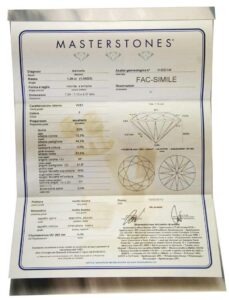The Center of Gemological Analysis Masterstones foresees a clear record for the choice of diamonds treatments and quality elements.
Every diamond undergoes a test with D – SCREEN (HRD) for a preliminary investigation (UV transparency to shortwaves) on a possible discoloration treatment (HPHT) or synthesis (CVD). If the test result is positive, the diamond choice through IR spectrophotometry and the Raman spectroscopy for an exact diagnostic starts. Treatments such as emerging splits filling by “high density glass” or the presence of channels made by laser techniques for inclusions removal can be observed by standard gemological tools.
Mass evaluation
Mass is evaluated by a precision scale in metrical carats (ct). The value is expressed in five decimals. Based on 9758 UNI law, the diamond mass is approximated in excess just when the third decimal number is 9 (0,99900 equals 1 carat).
Shaping and cutting
Nomenclature reported in 10173 UNI LAW is used for the choice of diamond shaping and cutting type.
Dimensions evaluation
Diamond dimensions are evaluated with electronic gauge and expressed in millimeters (mm) with almost two decimals. As far as round gems are concerned, a minimum or maximum diameter is calculated besides height. For the other shapes, the order of calculation criteria is : width, length and eight.
Fluorescence
The diamond undergoes ultra – violet radiations with a wavelength equal to 365 nanometers (UVL) released by a Wood lamp with cobalt filter located in a darkroom. The fluorescence intensity is expressed, with the help of comparison gems, using the following definitions: none, weak, average and strong. The fluorescence color is not mentioned.
Inside features classifications.
The gem is observed through a 25 enlargement microscope in dark field for the inclusions’ individuation and possible evaluation with the help of a specific reticulum provided eyepiece. Inclusions are indicated through symbols proposed by UNI LAWS (Prof G. Lenzen), respecting dimensions and position. Inclusions are always indicated by RED color. The grade of internal features is evaluated later through the observation of possible inclusions with a 10 extensions triple lenses. The internal features grade is given according to the following evaluations scale: IF, VVS1, VVS2, VS1, VS2, SI1, SI2, P1, P2, P3 (9758 UNI).
Color classification
Diamond color is calculated through gems comparison belonging to a 10 comparison master stones set. These stones have already been classified and certified by HRD in Antwerp according to the lower limit of GIA (Gemological Institute of America) scale. Light is provided by a normalized light lamp (5500 – 6500 K°). The followed classification is the GIA one: D/E/F/G/H/I/J/K/L/M/N/O/P/Q/R/S/T/U/V/Z fancy. In order to confirm result given by the observation through color comparison, the diamond undergoes a colorimeter test (Sarin DC 3000) and a further one performed by a tool developed inside the laboratory with a dedicated software. Fancy diamonds classification is based on “Munsell” color cards, under a normalized artificial light, using the following basic colors: red, pink, orange, yellow, brown, green and blue. The stone shade is mainly judged from the table, while color intensity is mainly judged from the pavilion and from the crown. (9758 UNI LAW).
Cutting proportions
Diamond cutting proportions are determined by using Sarin, DiaVision and SPlus electronic proportiometers. These make the examined gem graphic reconstruction possible by recognizing every single face percentage values and inclination degrees and by providing indications for a possible re – cutting. The following percentage values are expressed in the analysis document: table diameter – crown height – belt thickness – pavilion height – total height – upper faces edges – lower faces edges. The values concerning the crown and pavilion corner are expressed in degrees. Cutting proportions are evaluated as follows: Excellent – Very Good – Good – Poor.
Symmetry
The symmetry judgment is based on the observation of all faces, including the upper table. Their shape, inclination, edges correspondence, corners closures and many more further aspects which are really important for gem beauty are taken into account. Judgment grades are the followings: Excellent – Very Good – Average – Poor.
Finishing
The finishing evaluation comes after the observation of faces cleansing, which is evaluated through the visibility and number of defects which can be observed through a 10x lens. Evaluation criteria for both parameters are: Excellent – Very Good – Average – Poor.
Belt and top look
A diamond belt can be frosted, multiple face, clean. Besides the look, the thickness, already mentioned as percentage value in proportion is considered. Thickness is evaluated ad follows: very thin – thin – average – thick – very thick. Top look is evaluated as follows: sharp – multiple faces (small, medium , large) – damaged – scraped.
Filing
The analysis document drafts leads to the creation of a folder comprehending different documents during exam. Such documents are signed by analysts with maximum secrecy. The folder has the same number as the analysis certificate and can, therefore, be easily tracked down. We need to point out that the documents do not show the name of applicant. In order to ensure a bigger analysis documents integrity, applicants can check their own document entering its number.
***
Every analysis is performed in compliance with national and international effective rules and follows the same principles as the major gemological institutions. The issued documents are signed by at least two gemologists.

